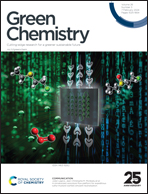High performance, self-adhesive and recyclable dynamic crosslinked waste rubber particle blends toward upcycling of waste rubber†
Abstract
The upcycling of waste rubber is crucial for the green development of the rubber industry. However, the current state of the waste rubber recycling strategy has defects such as poor mechanical properties and narrow application ranges of products, known as downcycling. Herein, an upcycling strategy for waste rubber is developed based on constructing covalent adaptive networks (CANs) in both the interface and matrix of waste rubber blends, endowing waste rubber products with high mechanical performance, self-adhesive properties and recyclability. Waste rubber particles are carboxylated by the grafting reaction of acrylic acid to enable the formation of β-hydroxyl ester linkages with epoxidized natural rubber, which effectively avoids stress concentration and thereby evidently improves the mechanical strength of the blends. Moreover, these waste rubber blends exhibit excellent self-adhesive properties, which could be applied as high-value structural adhesives. Owing to the dynamic nature of CANs, the value-added waste rubber blends have reprocessability, realizing long-term recycling of waste rubber. This work proposes an effective strategy for upcycling of waste rubber.



 Please wait while we load your content...
Please wait while we load your content...